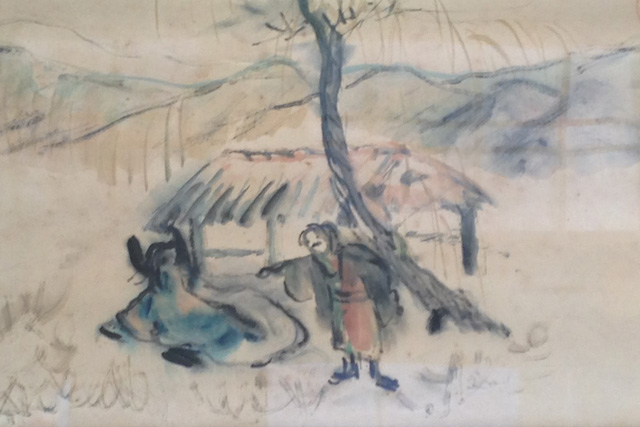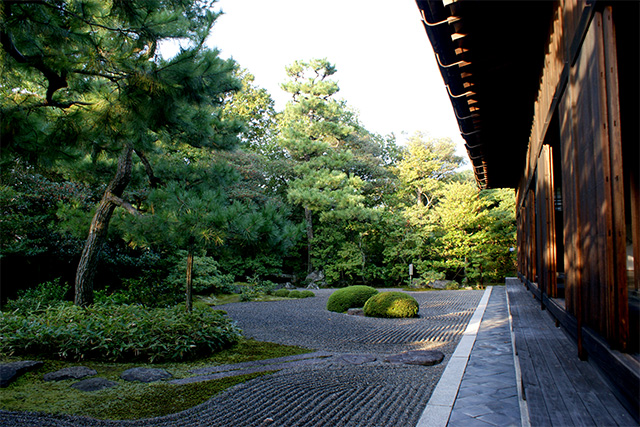
|
|
According to tradition, Zen Buddhism was established in the early 5th century by the Indian monk Bodhidharma in China based on the teachings of Sakyamuni, the founder of Buddhism. Zen Buddhism was transmitted to Japan and Zen culture began to flourish in Kyoto during the 13th century.
Many people may think that Zen is a spiritual philosophy to achieve satori or enlightenment through seated meditation, or zazen. It is said that it is not possible to understand Zen teachings by words, rather, you have to experience it yourself. Zen teaches that each of us has Buddha nature. If you are aware of your true nature, you can live by focusing on the present moment with your full body and mind, not in the past or the future.
Kyoto has been the center of Japanese culture for more than 1200 years. Zen has influenced the lifestyle of the Japanese. Kyoto has rich Zen culture. The austere simplicity of many facets of Japanese culture is associated with Zen. You may be able to discover the source of the Japanese spirit in Zen.
The best way to understand Zen and Japanese culture is to try Zazen yourself. You can experience Zen in Kyoto.
|
|
|
|
|
|
|
|
|

|
|
Deputy Head Priest of Shunko-in Temple & International Zen Center in Kyoto/ U.S. – Japan Leadership Program Member/ LGBT Activist
Takafumi Kawakami majored in religious studies at Arizona State University in the United States, and upon returning to Japan has taught about Zen in English to over 10,000 foreigners. He has also led Zen workshops at universities in America. He focuses on the effects Zen has had upon Japanese culture and tradition, and on how to connect Zen and Buddhist teachings to daily life through neuroscience and psychology.
He is an LGBT activist, promoting and supporting rights by providing spiritual unions for same-sex couples at the temple as a member of the Buddhist clergy.
|
 |
 |
|
―Can you give us a brief overview of what Zen teaching is?
Zen teaches people to have right mind and body for a happy life. It is learning to perceive yourself and facts objectively. You look at yourself the way you are and things the way they are. You live by concentrating on the here and now in the present moment. You eat when you eat. You walk when you walk. Many people live in the past, thinking about how things could have been better, or, live in the future, thinking about where to go for lunch.
―What is satori or enlightenment?
Satori is to be aware about reality and transience in this world. It is the awareness that everything in this world changes and nothing stays the same. The fully-bloomed cherry blossoms fall. A child is born, the child grows up and the parents grow old. You will be able to view things in relative ways. You will experience what goes on in the world with full use and capacity of your five senses.
Many people are searching for something important somewhere in the world outside but they will only find it within themselves. Witnessing something mundane in a normal day may bring upon sudden enlightenment. Satori is in there every moment of your life. Time goes on forward and never backward. This is something so natural that we barely even notice in our daily life. Satori is nothing special. You should not expect good things from Satori. It is an awareness of everyday things in reality.
―What is the concept of ‘no-self’?
This concept means to perceive the world objectively, not subjectively. A subjective perspective is usually the cause of suffering, as it emphasizes duality and the ego. An objective viewpoint emphasizes seeing the world without the filter of the ‘self.’
|
 |
 |
|
―What is Zazen?
Zazen is seated meditation and the most basic tool for awareness. It is a practice of mindfulness. You sit with your neck and head aligned with your spine, brining the body into proper alignment. You then concentrate on your breathing. It is easy to become more subjective when you become emotional. Try sitting causally even for 5 minutes every day. It will make a difference.
―What kind of people is coming to Zazen?
Many people in their late 20’s or early 30’s who have experienced the trials and tribulations that most people have in life. People who have learned from these experiences, and want to understand that the way the past has influenced the present or future cannot be judged as negative or positive, it is just neutral.
|
| |

 |
|
―What is expressed in Zen gardens?
Zen gardens are spaces to rake the gravel into patterns. We call the patterns samon or ‘sand mark.’ Samon can express flowing water, the surface of the sea, or even clouds. They are made by a special rake. Raking the gravel is an opportunity to learn about living this moment here and now by drawing a line in one direction. Once drawn, the marks are now already in the past; they are a result. This is the same direction as the flow of the time. People who can focus on the present are able to draw beautiful lines. It is a good way to learn to be in the moment. The patterns raked today will be gone tomorrow if it rains. One can learn that all worldly things are transitory and impermanent. Anything done today is only temporary and will be gone simultaneously. You are living in the past if you are attached to something.
―Why do we feel calm in Zen gardens?
Zen gardens are small and compact. They are simple, neat and clean. People feel peace in a closed space. I prefer going to a Zen temple in the morning or evening when there are not so many people.
―Why are there 15 stones in the rock garden at the famous Ryoan-ji Temple?
Within East Asia, the number 15 is related to the concept of perfection. The full moon becomes the new moon, or vice versa, every 15 days. The moon becomes full in 15 days. No matter which angle from which you see the rocks, you are not able to see all 15 of them at the same time. It shows us that human beings are not perfect.
|
 |
|
―Where can we see the local life in Kyoto?
You can go to Sanjokai Shotengai Shopping Arcade to see how locals live. The neighborhood remains traditional but there are contemporary living spaces. There are all kinds of daily necessities there. One interesting spot is a machiya cafe in a traditional Kyoto townhouse, run by Randy Channell Soei, a Canadian master of Chanoyu, or the ‘Way of Tea.’ The philosophical concept of Chanoyu is linked with Zen. “One time, one meeting”, a term by a famed tea master, means “one chance in a life time”.
―Tell us any shops you recommend.
I like authentic artisan’s crafts that enrich everyday life. A true craftsman can design new items that are functional in today’s life, but that still are made with traditional techniques. Kyoto is proud of its quality artisan craftspeople. You should visit shops and see their crafts in person to understand the value.
Artisans have to be free and keep an innovative mind to explore new styles throughout the ages. A fixed or biased idea has to be discarded. Ideas about common sense today will be different in 100 years. There is not only one right way. All things have to be customized in the right way to meet the needs for today.
Understanding Zen can help people understand Japanese culture.
|
 |
|
―How can we use Zen in our daily life?
The advantages of meditation or mindfulness are studied at many universities, including Stanford University and UCLA. Zazen is useful to help treat stress and depression. Scientific study can help us see what happens in the brain during meditation. The brain is where most of the body’s energy is consumed. Science can help us to understand zazen.
You can be more successful at work if you perceive this world objectively. You will step back and see the whole picture. Your emotional feelings are temporary. Zazen can make you see your daily life in a different light. You do not have to live as a hermit. You can live in any situation with a Zen mind. The essence of Zen teaching can be useful throughout daily life.
|
|
| ZEN Temples for Zazen Experience |
|
|
| Rev. Taka’s Recommended Zen Temples |
|
|
| Rev. Taka’s Recommended Shops and Cafe |
|
















